We’ve spent some extra time thinking about how to forage in Georgia and now it’s time to consider what to forage in Georgia. Foraging, as we have defined, is going out to gather various edible items from the environment.
We’ve already spent some effort talking about edible landscaping, where you plant something in your yard that you can eat. This is all about the practice we call “human scale living” which means we like to be aware of the resources around us.
Funny story about Foraging
If you do a search engine search for “foraging in Georgia” it comes back with a lot of articles from UGA School of Agriculture. “Forage” to them is some nice grass plant that you can grow to feed your goats. We’re talking about ryegrass, alfalfa, bermuda and the like.
Ryegrass is a possible exception to the joke because of course some varieties of this are suitable for human consumption.
But to be clear, we’re not really talking about going out and eating alfalfa.
Disclaimer
A couple of things: As usual, this is being posted for entertainment purposes only. You’re on your own if you actually decide to try any of these things. We’re not doctors either so if we say something is healthy the best course of action is to not believe it unless you seek out other sources.
That being said, there is a huge amount of time and money being spent to make you too fearful to find free food. We can get into some more detail on this sharing the sacraments if you wish.
Acorns
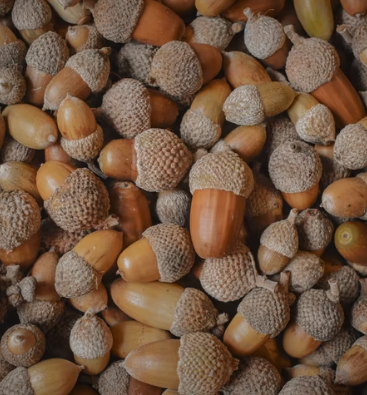
Okay then, you know all of those acorns that you complain about every year? The ones that litter your front porch, and hurt when they’re hit by the lawn mower? Well, come to find out they’re edible.
I suppose this was common knowledge for a long time.
The drawback is, that because of the tannic acid that is in them, they taste terrible until you process them, and that takes work.
Acorn Refining:
Here are the steps in this, gathered from a variety of resources:
| Step | Activity | Comments |
| 1 | Gather acorns | Best done in the fall. Acorns tell you when they want to be found by falling off the tree |
| 2 | Remove excess debris and sort | Any nasty acorns with worm holes should be discarded. Check this by putting the acorn in water. If it floats, send it to compost |
| 3 | Remove hard outer coating | Preferred tool for most foragers is an old hammer. It takes a bit of touch to know how hard to hit the acorns. Yes, the “meat” of the acorn is the inside part which looks like it should be edible. |
| 4 | Grind “meat” | We believe that a thrift store food processor is sufficient for this. What you want to do is chop this into smaller chunks so as to increase in surface area. |
| 5 | Extract the tannin | This is the complex and repetitive part. Find a clean bucket, throw in the free meat, which is edible, and immerse it in water. There is some disagreement in the literature about whether to use cold or warm water. Cover the acorn product with water and allow to rest for 3-6 hours. The people experienced at this say that it takes 5-6 repetitions of this to make the resulting meat (which is called the “Testa”) edible. So you have to have a way to keep this clean and keep the contamination out of it. |
| 6 | Dry the now-edible acorn testa | This can be done using an oven, or one of those food dehydrators, |
| 7 | Further grind the particles into finer pieces | This can be done using a rolling pin or other suitable way. |
Good news about Acorns
Well, as any squirrel will tell you, converting acorns into edible food will keep you going for a long time.
According to one of the sources below, there are enough acorns in one tree to keep a couple of people from starving for a year. Dry them out before you try to store them.
There are a couple of recipes available for acorn flour. Matt, from “In the kitchen with Matt” has a suggestion for acorn bread.
Not widely known fact about the Pilgrims is that one of the things that got them through the first winter is use of acorns to make beer, which is something that ought to be tried at some point.
Bamboo
The Asians figured out about 6000 years ago that bamboo is the gift that keeps on giving. This plant, which is part of the weed family, grows like a weed anywhere that it rains.
Around the Firefly there are several spots along the road with various types of bamboo.
Bamboo shoots, properly prepared, of the right variety, are edible.
They can also be used to construct a picnic table, utensils, dinnerware, and napkins, for someone that is skilled in this.
We’re talking about eating at the moment.
Here’s the drawback: picking out the right variety. There is a link below, that lays out the 100 varieties of bamboo that are edible. Here’s your further drawback, which is, that nobody in rural Georgia is all that familiar with bamboo varieties, and can tell one from another, because it’s not in our culture to use this as a resource.
Based on extensive research, it looks like the best option for determining whether bamboo is edible is to do the work to process it, and see if it can be eaten. It’s not poisonous at least, and the worst that can happen is that the shoots are too fibrous to eat. If that is the case, your fallback position is to feed it to the chickens and laugh because we don’t fear failure like that.
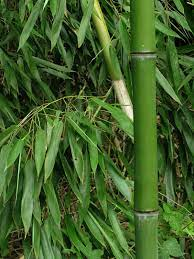
Bamboo as an Invasive Species
However, the good thing is that bamboo grows and spreads, and once you locate a lot of bamboo that you know is edible, you can go back to the same spot.
Another option: order some edible bamboo and plant it. The locals around Madison have a bit of a negative view of Bamboo, because of its tendency to overspread and take over the area. It’s the shoots, namely the little new sprouts that emerge in the spring, that are edible.
Side point: There are only three native species of Bamboo in North America. Therefore there is a high likelihood that any bamboo you see growing along the road, or in the back of a vacant lot is invasive. In theory, since foragers like to focus on invasive species, it’s fair game to “harvest” it with permission.
Bamboo Shoot Preparation
| Step | Activity | Comments |
| 1 | Harvest bamboo shoots | Do in spring or early summer, when they’re the most tender. Use a machete or hammer to bust the shoot off. |
| 2 | Peel outer layers of bamboo, remove dirt and contamination | Can be done by hand. Rinse each layer |
| 3 | When inner layer is finally revealed, trip top and bottom | use big kitchen knife |
| 4 | Boil in boiling water until soft | Can be done in bamboo steamer |
| 5. | Remove from water. Peel off tough outer layers, if possible | At this point you will know whether that variety of bamboo is edible. If the very inner layer is fibrous you have the inedible variety. |
| 6 | Serve per serving suggestions below | There are various ways to use this, eating as a side dish, as an ingredient in ramen, or in stir fry. |
Bamboo Eating Suggestion
That spicy peanut dip that we made when we made the Chicken Satay should be perfect. Mee Living may give you a few pointers, because she is of that culture. She got her bamboo from the exotic bamboo production land North Carolina.
Wild Potatoes
There is such a thing as wild potatoes, and according to this research, these things grow in the area.
Here’s a picture:
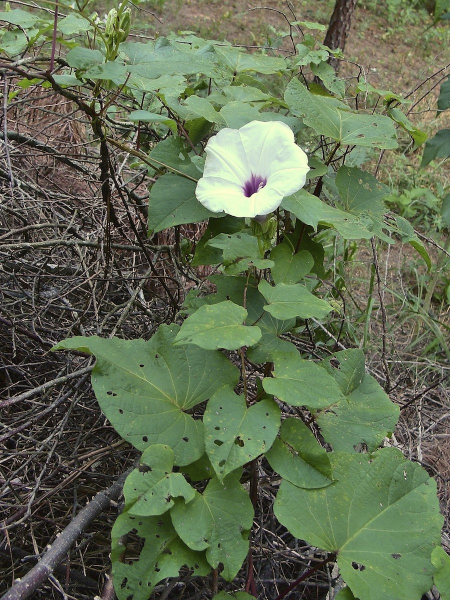
Wild Potato Vine
Wild potato vine is a member of the same family as the sweet potato. Therefore they’re edible and under-appreciated. The vine itself, as you can see, has a lot of white flowers with red inside. Don’t eat the vine or plant. The edible part of it is underground. It is considered a tuber.
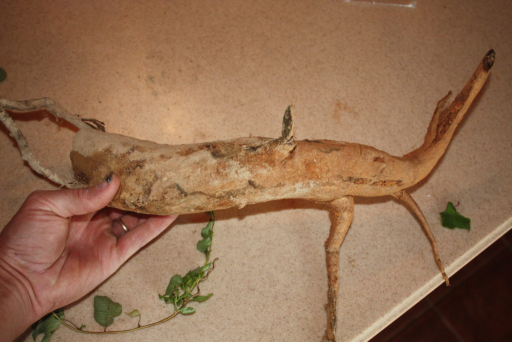
According to Eco Farming Daily, the best place to look for this is growing along fencerows. The plant itself is also of the same family as the Morning Glory, which is toxic. The distinguishing features are the heart shaped leaves, and also the characteristic flower.
According to Gardenia.net, these things are heat tolerant, native to Georgia, and can be trained to climb up a pergola or trellis if you like the flowers. This would make it edible landscaping as well. In places where it is considered a pest, it is nearly impossible to kill it, because the root system is regenerating.
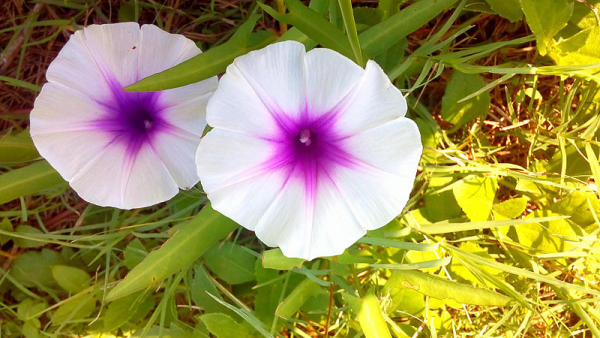
According to some resources, some of these varieties are toxic to dogs and cats. Presumably, unlike humans, they have the brains to leave it alone after the first negative experience. Another name for this is “man of the earth”. The “eco farming” people say that these roots can be dehydrated and stored for many months without refrigeration.
The cooking method? Well it looks like you have options. Once you dig the root out with a shovel, and wash the Georgia dirt off of it, you bake it like a sweet potato. Alternately you can cut it up and fry it with butter, salt and pepper.
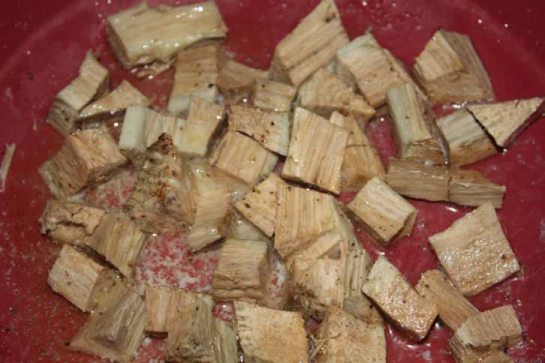
Additional Reading
Here is a recent article about edible weeds in Georgia that you might like. Maybe you can forage close to home.
What to Forage in Georgia
So here you have it. With this, along with some edible landscaping, you should be able to build up to your 2000 calories a day, especially if you can supplement it with a little garden food.
These things are readily available as long as there is not much competition. Six million people foraging the area around Madison is going to pick the place clean, so we’d better hope that doesn’t happen.
It looks like a better approach is going to be to learn to grow some root vegetables. We’ll have to do some further research on that topic but based on what we know now, it’s easy, and might be preferable to foraging.
As always, if you want to stop by and see what is in the area, and walk around the place, you’re perfectly welcome. Click the “book now” button.
Links and References
Pilgrims
Tyrant Farms
https://www.tyrantfarms.com/diy-how-to-make-acorn-flour-acorn-recipes/
Edible Bamboo
https://www.guaduabamboo.com/blog/edible-bamboo-species
Bambu Bata
Eco Farming Daily
Harvesting, Preparing Wild Potato
Gardenia.net
https://www.gardenia.net/plant/ipomoea-pandurata
![]()
